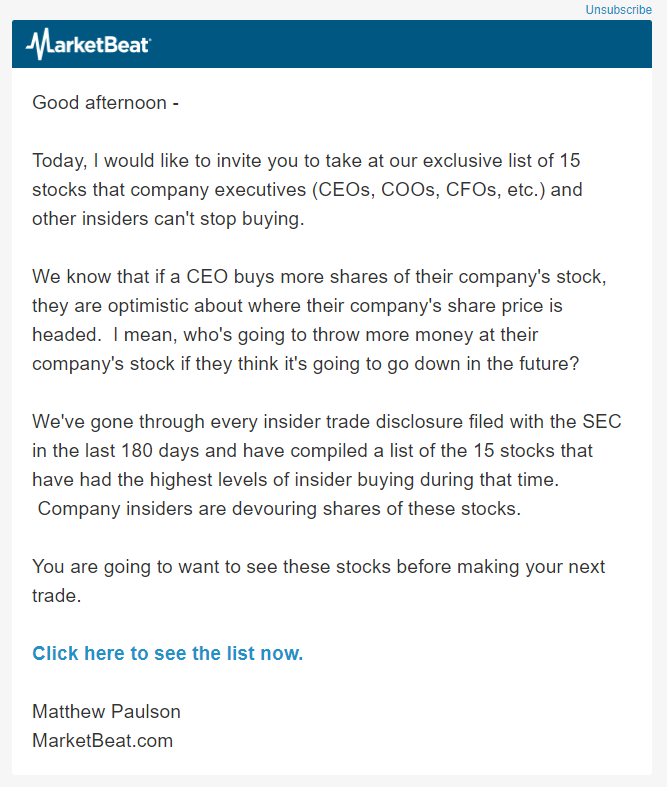When it comes to email marketing, having a bigger list is not always better. It’s not the marketer with the biggest email list that wins, it’s the marketer that has the most engaged audience that wins. Email service providers are looking at engagement statistics (open rates, clickthrough rates, subscriber replies, spam reports) more than ever to determine which messages belong in the spam folder and which messages belong in the inbox. Your email service provider will likely automatically remove email addresses that are invalid or report your message as spam, but they won’t always stop emailing unengaged recipients. Therefore, it’s important to proactively go through your email list periodically and remove users that haven’t opened any of your emails for several months.
There was a recent article on Digiday that talked about how publishers have tried to re-engage dormant subscribers, and I thought it would be a good idea to walk through how MarketBeat does email sunsetting (removing inactive subscribers from one’s mailing list) and re-engagement (trying to get inactive users to start opening your messages again). MarketBeat publishes six free daily investment newsletters, currently has about 1.25 million total subscribers, and receives about 50,000 new email sign-ups each month. It’s important to note that MarketBeat is a high-volume sender (2 email messages per subscriber per day), so our sunsetting policies are much more aggressive than a company that only sends out one email per week would need to practice.
How MarketBeat Does Sunsetting
Our general practice for sunsetting is simply to send less email to unengaged subscribers. As the length of time increases from when a user last opened a message from MarketBeat, we send them less email. We never actually remove unengaged users from our list, we just mail them much less often (approximately once per month).
Here’s an overview of the specific triggers we use to determine which subscribers should get less email:
- Subscribers that have opened a message from us in the last 30 days will receive their newsletter five days per week and all other marketing and content emails.
- Subscribers that have opened am message from us in the last 60 days will receive their newsletter three days per week, but no marketing or content emails.
- Subscribers that have opened a message from us in the last 90 days will only receive their newsletter one day per week, but no marketing or content emails.
- Subscribers that haven’t opened a message from us in the last 90 days will receive no newsletters, marketing emails or content emails and will only get periodic re-activation campaigns.
- Marketing emails from advertisers and content emails that highlight specific articles or reports on MarketBeat’s website are only sent to people that have opened at least one newsletter from us.
- Users that don’t open or click through on a single email from us in the first 30 days of their subscription are permanently unsubscribed from our mailing list. This is key.
- Invalid emails, bounced email addresses, and users that report MarketBeat’s messages as spam are permanently removed from our mailing list.
How MarketBeat Does Subscriber Re-Engagement
In the past, MarketBeat would send a traditional re-engagement campaign of 10 messages over several weeks telling their subscribers that their account was inactive, that they would stop getting their newsletters, and that they needed to re-confirm their subscription. We found, at least in our case, these emails simply don’t work. Subscribers that aren’t opening your emails don’t care that their account is inactive and are very unlikely to re-activate from a traditional re-engagement campaign. Our re-engagement campaign had an open rate of less than 1% and got very few click-throughs, so we decided to try something different.
While we do send a couple of courtesy messages telling our subscribers that we are going to stop emailing them their daily newsletters, our primary re-engagement campaign now involves sending out our most engaging content to all our subscribers. We have a handful of free reports that have historically gotten very high open rates and very high click-through rates from our subscribers, so we will simply send one of those emails to all of our subscribers (regardless of when they last opened an email) once or twice per month. By sending the message to everyone, our email will still have decent engagement rates which will keep email service providers happy and keep our email campaign out of the spam folder. If an inactive subscriber opens our high-engagement content piece/re-activation email, we will reset the clock on their date of last activity and start sending them their newsletters again.
When we send out a highly-engaging email to our entire mailing list of 1.25 million people (and not just the 755,000 subscribers that have opened a message from us in the last 90 days), we find that we can reactivate 5,000 to 10,000 subscribers of our ~500,000 inactive subscribers.
Here is an example of a highly engaging email that we recently sent to reactivate inactive subscribers.

Wrap-Up
Our sunsetting policies and re-activation campaigns aren’t perfect, because email deliverability is as much of an art as it is a science. There’s always a balance between maintaining high engagement and making sure that all of your subscribers that want your messages are actually getting them, but these strategies have kept our inbox rate above 85% across all email service providers. What’s right for your email list will depend largely on how often you email and what types of messages you send, but it is critically important to make sure that you are only emailing engaged subscribers most of the time.
